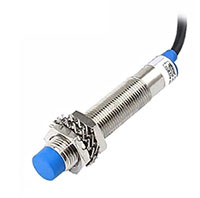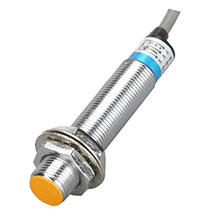Proximity Sensors Basics: Working Principle, Type and Application
The proximity sensor is a general term for sensors that detect objects without touching them instead of contact detection methods such as limit switches. The sensor converts the movement and presence information of the detected object into an electrical signal. Among the detection methods that convert the information into electrical signals, some methods utilize the eddy current generated in the metal body of the detection object due to electromagnetic induction, methods that change the capacity of the electrical signal due to the proximity of the detection object, and methods that use a sharp stone or a guide switch, etc. ATO.com will introduce the basics such as the principle of operation, types, and applications of the proximity sensors in detail in this article.
Outline
The proximity sensor is a device with the ability to sense the proximity of an object, which utilizes a displacement sensor with sensitive characteristics to the approaching object to identify the proximity of the object and outputs the corresponding switch signal, therefore, the proximity sensor is also usually referred to as a proximity switch. It is a general term for sensors that are designed to detect the movement and presence of an object without contacting the object to be detected instead of the contact detection type detection method such as switches, and it is capable of detecting the movement and presence information of the object and converting it into an electrical signal.
In the JIS definition, sensors that can detect the proximity of an object and the presence or absence of an object in the vicinity of the sensor in a non-contact manner are referred to as "proximity switches," and are composed of inductive, electrostatic capacitance, ultrasonic, photoelectric, magnetic, and other types. For this technical guide, inductive proximity sensors that detect the presence of metal, electrostatic capacitance proximity sensors that detect the presence of metal or non-metallic objects, and switches that utilize a DC magnetic field generated by magnetic force are defined as proximity sensors.
Principle of Operation
The detection principle of inductive proximity sensors: The magnetic loss caused by eddy currents generated on the surface of a conductor is detected through the influence of an external magnetic field. This is a method of detecting the change in impedance caused by the eddy current generated in the metal body of the sensor by generating an AC magnetic field in the sensor coil and detecting the change in impedance caused by the eddy current generated in the metal body of the sensor body.
In addition, as another approach, an aluminum detection sensor that detects a frequency phase component and an all-metal sensor that detects only the impedance change component using a working coil are included. The state of the transformer occurs on the surface of the detecting body side and the sensor side.

Types of Proximity Sensors
Capacitive Proximity Sensor
The capacitance proximity sensor is an electrode for the detection end of the transconductance capacitance proximity switch, which consists of a high-frequency oscillation circuit, detection circuit, amplification circuit, shaping circuit, and output circuit. Normally there is a certain amount of capacitance between the detection electrode and the earth, which becomes an integral part of the oscillation circuit. When the detected object is close to the detection electrode, due to the detection electrode with voltage, the detection electrode will be subjected to electrostatic induction and polarization phenomenon, the closer the object under test is to the detection electrode, the more inductive charge on the detection electrode of the high-frequency capacitive proximity sensor.
As the electrostatic capacitance on the detection electrode is C, the capacitance C of the detection electrode increases with the increase in the amount of charge. Since the oscillation frequency of the oscillation circuit is inversely proportional to the capacitance, when the capacitance C increases the oscillation of the oscillation circuit is weakened, or even stops oscillating. The two states of the oscillation circuit, oscillation and stoppage, are converted into switching signals by the detection circuit and output to the outside.
Inductive Proximity Sensor

The inductive proximity sensor consists of a high-frequency oscillation circuit, a detector circuit, an amplifier circuit, a shaping circuit, and an output circuit. Detection of sensitive components for the detection coil, which is an integral part of the oscillation circuit. When the detection coil is energized with alternating current, an alternating magnetic field is generated around the detection coil. When a metal object is close to the detection coil, the metal object will generate eddy currents and absorb the magnetic field energy, so that the inductance L of the detection coil changes, thus reducing the oscillation frequency of the oscillation circuit to the point of stopping the oscillation.
The two states of oscillation and stopping are converted to switching signals by the monitoring circuit. It should be noted that, like capacitive proximity sensors, inductive proximity sensors detect the object to be measured is also a metal conductor, non-metallic conductors can not be measured by this method. The amplitude change varies with the type of metal of the target object, so the detection distance also varies with the type of metal of the target object.
Photoelectric Proximity Sensor
Photoelectric proximity sensor, light-emitting diode (or semiconductor laser tube) beam axis, and the axis of the phototransistor in a plane, and at a certain angle, the two axes in front of the sensor intersected at a point. When the surface of the detected object is close to the intersection point, the reflected light of the light-emitting diode is received by the phototransistor, generating an electrical signal.
When the object is away from the intersection, the reflection area is not in the phototransistor's perspective, the detection circuit has no output. In general, the driving current sent to the light-emitting diode is not a DC, but a certain frequency of alternating current, so that the receiving circuit is also the same frequency of the alternating signal. If the received signal is filtered to allow only the same frequency signal to pass, it can effectively prevent the interference of other stray light and can improve the luminous intensity of the light-emitting diode.
Proximity Sensor Features
- Since they can be detected in a non-contact manner, they do not wear out or damage the object to be detected.
- Extended life due to contactless output method (except for magnetic type) Semiconductor output is used, which does not affect the life of the contact.
- Unlike the optical detection method, it is suitable for use in environments such as water oil, etc. Detection is virtually unaffected by stains, oil, water, etc. on the test object. Teflon housing types and products with good resistance to chemicals are also available.
- High-speed response compared to contact switches is possible.
- Compatible with a wide range of temperatures
- Detects changes in the physical properties of the test object without being affected by the color of the test object, so it is virtually unaffected by the color of the surface, etc.
- Unlike the contact type, the sensors are affected by the ambient temperature, the surrounding objects, and similar sensors, including inductive and electrostatic capacitance types, and the sensors interact with each other. Therefore, it is necessary to consider mutual interference when setting up sensors. In addition, in the inductive type, the influence of the surrounding metal needs to be considered, and in the electrostatic capacitance type, the influence of the surrounding objects needs to be considered.
Applications
- Proximity sensors are mainly used to detect the displacement of objects and are widely used in aviation and space technology as well as in industrial production. In daily life, they are used in hotels, and restaurants, automatic doors in garages, and automatic heaters.
- In security and theft prevention, such data archives, accounting, finance, museums, vaults, and other important places, are usually equipped with a variety of proximity switches composed of anti-theft devices.
- In measurement technology, length, and position measurement.
- In control technology, such as displacement, speed, acceleration measurement, and control, are also users of a large number of proximity switches.
In the rapid development of modern technology, proximity sensors, as a key sensing technology, bring great convenience and benefits to our life and industrial field. By accurately detecting the distance of objects, proximity sensors play an irreplaceable role in automation systems, intelligent devices, and safety control. It not only increases productivity and reduces energy consumption, but also improves user experience, enabling smarter and more sustainable development in all industries.

